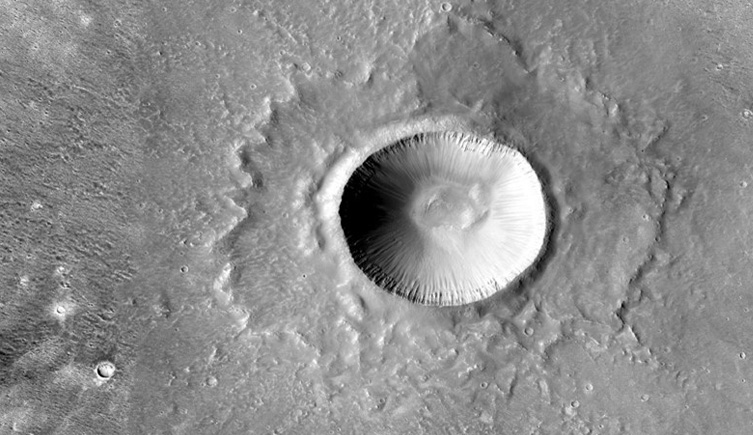Project overview
Nakhlites are a unique suite of ~20 Martian meteorites. They are basaltic pyroxenites with mineralogies dominated by cumulative pyroxene and olivine.
Traditionally considered to represent a shallow igneous sill, recent models suggest that the nakhlite meteorites sample several different lava flows, all from the Amazonian period about 1.3 Ga. Additionally, nakhlites are known to have the best evidence for fluid alteration within the Martian surface/subsurface, hosting a range of secondary phase assemblages. Alteration minerals include Fe,Mg-phyllosilicates (clay minerals), carbonates, sulphates and halides all of which likely formed during brief aqueous subsurface events. The nature and origin of these secondary minerals has been studied with a view to constrain the fluid geochemistry and the habitability of the Martian subsurface.
Systematic petrography and geochemistry have grouped the nakhlite meteorites into distinct lava flows from up to four eruption events. However, many inconsistencies remain regarding geochemical characterization of separate flows and their petrofabric characteristics [e.g. 1,2].
Furthermore, discrete oxidation processes during eruption are recorded in some of the nakhlites [3] with some features suggestive of magma contamination. Therefore, the evolution of magma in the nakhlite magma chamber is expected to be complex and is still subject to debate. Indeed, whether nakhlites originated from the same parental melt or from multiple magmatic systems has yet to be clarified. By investigating crystallization dynamics and relative timescales for the nakhlites, temporal constraints may be developed for the nakhlite magmatic system.
Project description
This project is a multi-disciplinary study in which the student will analyse the chemistry and petrography of nakhlite meteorites (11 nakhilites are already available at the Natural History Museum). We will use petrographic techniques to identify specific chemical textures within the pyroxenes and olivines.
Mineral composition and thermodynamic modelling will be used to establish mineral-mineral and mineral-liquid equilibrium and infer pressure, temperature and oxygen fugacity conditions during crystallisation.
Quantitative and greyscale imaging from electron microscopy will be used to develop systematic diffusional models [4,5]. This will establish pre-eruptive processes, and lava emplacement histories. In addition to utilising instrumentation within the Image and Analysis Centre (Natural History Museum), there is scope to perform micro- and nano-scale microscopy at international research facilities such as Diamond Light Source (https://www.diamond.ac.uk/).
This project is particularly timely with respect to the ongoing and planned space missions by the North American and European space agencies (NASA and ESA). NASA’s Curiosity Rover (Mars Science Laboratory), Mars Reconnaisance Orbiter, and ESA’s Trace Gas Orbiter are all currently operational while the Insight mission ended in December 2022. The Mars 2020 Perseverance rover continues to explore the Jezero Crater region and collect samples as part of the NASA-ESA Mars Sample Return mission.
Application Process
Deadline: Sunday 2 February 2025.
Applications will be opening soon
You will need to prepare the following documents:
- Curriculum vitae
- Covering letter outlining your interest in the PhD project, relevant skills training, experience and qualifications, and a statement of how this PhD project fits your career development plans.
- Transcripts of undergraduate and Masters’ degree results.
- Two academic references including (if applicable) Masters’ project supervisor.
We strongly recommend contacting potential supervisors in advance, so that you can ask any questions, and also meet the supervisory team before you apply. This project is eligible for funding from the Science and Technology Facilities Council, who provide information for students: https://www.ukri.org/what-we-do/developing-people-and-skills/stfc/training/studentship-information-for-students/
This is a competitive application process. All applications will be reviewed by the project supervisory team and an academic panel. Shortlisted applicants will be invited for an interview, which usually lasts 30-60 minutes. As part of the process, shortlisted applicants will also be offered the opportunity to visit the NHM, to meet the wider research group, and tour relevant facilities. Shortlisted applicants will usually find out the outcome a few days after all interviews have been held.
Additional information
We seek an enthusiastic person for this project with a strong background in the physical sciences or planetary sciences or geology, and with an interest in applying analytical mineralogy to a planetary science context.
The student will become integrated into the Planetary Materials Group and the Volcano Petrology Group at the Natural History Museum. The student will be affiliated to Birkbeck College University of London, and have the opportunity to study meteorites from one of the finest meteorite collections in the world at the Natural History Museum. The student will benefit from STFC-led training opportunities throughout the studentship.
Scanning electron microscopy (SEM) & electron microprobe analysis (EMPA) will be performed in house, at the Museum’s Image and Analysis Laboratories. If required, additional micro- and nano-scale X-ray microscopy will be undertaken at international synchrotron facilities such as the UK’s Diamond Light Source (www.diamond.ac.uk) using X-ray nanoprobes and scanning transmission X-ray microscopy (STXM).
